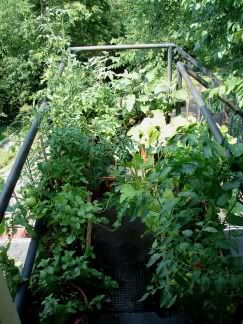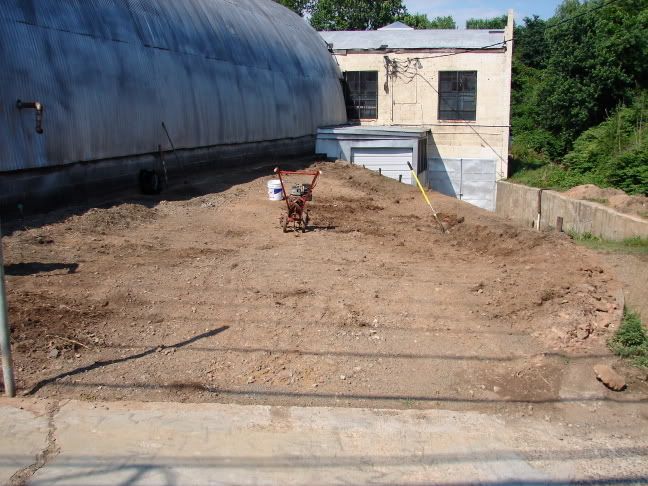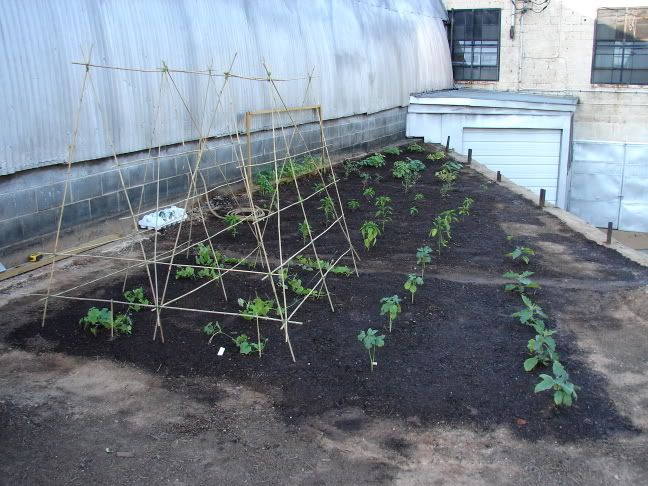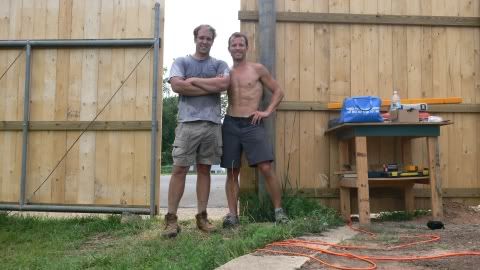 Locavore is a term that has been gaining currency in recent social and environmental discussions. In simple terms, a locavore is a person who prefers to eat only foods grown or raised locally (within a 100 mile radius) Locavores shun foods that have been imported, or transported great distances before arriving at the local grocery store.
Locavore is a term that has been gaining currency in recent social and environmental discussions. In simple terms, a locavore is a person who prefers to eat only foods grown or raised locally (within a 100 mile radius) Locavores shun foods that have been imported, or transported great distances before arriving at the local grocery store.
In 2005, a San Francisco Bay-area group established a set of criteria for locavores. You can learn more about the group here.
Political and moral imputations aside, eating food that is grown locally not only makes sense, but is often a more healthy way of eating. In terms of the venerable "Think Globally, Act locally" paradigm, becoming a locavore is a simple and practical way to implement positive change while supporting your local economy.
Patio Gardens
If closer to home is the ideal for the locavore, then "at home" patio gardens, rooftop gardens, or in my personal circumstance: The Fire Escape Garden is definitely the way to GROW. In roughly 30 square feet-leaving some minimal egress- my fire escape garden is a cornucopia of vegetable yumminess. I have grown this garden for the past 6 years, and have settled on the ultimate combination of Italian vegetables. I have 6 varieties of tomato, 3 of which are heirloom varieties, five varieties of pepper (red, yellow, orange, poblano and chilli) Ichiban eggplant, green eggplant, button squash, Burpless cucumber, as well as basil, mint, sage and tarragon.
In roughly 30 square feet-leaving some minimal egress- my fire escape garden is a cornucopia of vegetable yumminess. I have grown this garden for the past 6 years, and have settled on the ultimate combination of Italian vegetables. I have 6 varieties of tomato, 3 of which are heirloom varieties, five varieties of pepper (red, yellow, orange, poblano and chilli) Ichiban eggplant, green eggplant, button squash, Burpless cucumber, as well as basil, mint, sage and tarragon.
I like to host small dinner parties, and guests are always amazed by the fact that I freshly pick many of my dinner ingredients within sight of my kitchen, as I cook. I now grow many of my vegetable plants from seeds that I germinate in my apartment in peat during the Spring. In early May I plant my little garden and it looks like this. Each year my "little garden" generates about $400 worth of the freshest vegetables for me to enjoy. Careful watering, pruning and "kitchen composting" ensures growth through October.
I recently picked these veggies from my Fire Escape Garden
Recapturing Urban Garden Space
A few months back I decided to transform a former urban industrial site into an organic garden. The idea to convert the 1500 square foot side lot of an industrial building into a viable organic garden came to me through my involvement in The Hut Collective. For the past four years, my design and woodworking shop has been located in a 1950's Quonset Hut occupied by a small group of artists and craftsmen. [photo] In June I decided to direct my greener ambitions towards recouping and transforming some of the unused lot into a productive organic garden. The owner of the property was very encouraging and offered not only to help me, but gave me the salvaged wood I used to build the fence.
It took me two months to transform the once barren and rock-filled soil into something workable. After 10 yards of dark topsoil, and several yards of mulch, I began planting. What you see in the photo above was the garden in early July. The Chinese Okra has now outgrown its trellis, the peppers, eggplant, squash, cucumbers, and half-runner beans all have been producing impressive yields. My only disappointments were the heirloom tomato plants which have yielded little due to their late planting.
With the help of some friends, and countless gallons of sweat, shovelling and tilling, the project is almost complete. A 70-foot fence, made of salvaged shipping container wood, now encloses the garden. Next week I will be building a small greenhouse to ensure salad and other greens through the late fall.
- Green Idea 1 : ' Find your nearest Farmer's Market and go there this weekend with friends...
- Green Idea 2 : ' Swap your old incandescent bulbs for CFLs when they burn out and start saving $$$
- Green Idea 3 : ' Try using your bike this weekend instead of your car...
- Green Idea 4 : ' This Spring why not plant a small kitchen garden of tomatoes and peppers on your balcony or patio?
- Green Idea 5 : ' What are you waiting for? Make the change today!
-

SUSTAINABLE DESIGN
The basic objectives of sustainability are to reduce consumption of non-renewable resources, minimize waste, and create healthy, productive environments.
-

URBAN GARDENING
You can grow your own food whether you live on a rural farm or in a tiny urban apartment. Urban gardening is all about using space wisely to regain a closer connection with your food and beautify your home or neighborhood.
-

RENEWABLE ENERGY
Explore energy resources, such as wind, solar, hydroelectric, biomass, geothermal, ocean thermal, and wave power, that replenish themselves within a short period.
-

LOCAL FARMERS MARKETS
Locating the Farmers' Market nearest to you is now only a few clicks away. Localharvest.org is a useful and straight-forward site designed to faciliate your quest.


















10 comments:
Way too cool! I esp. love the fire escape garden concept.
Hey Verge, That is super resourceful of you! There is nothing like crunching into a capsican grown in your own kitchen garden. I haven't heard of the term, "Locavore" but am glad that I can now put a name to my enthusiasm for local "Farmers Markets" that we have in Australia.
Keep up the good work.
Terry
Next trip out to the Farmer's Markets in Melbourne, bring along a camera and snap some pics of you and the local "vegetables". I miss some of those aussie veggies [chocos, Kumera, custard apples etc]
Remember my place in Paddington? Banana plant and macadamia out back, mango in front, and passion fruit vines along the side.
That was living!
Your fire garden is a great inspiration to me as I'm in the middle of planning a vege garden right now.
Hello verge.
Innovative use of space....
Especially with Urban sprall, and the shrinking dimentions of living in apartments/units, space is of a premium.
The health benefits of fresh produce that isn't irradiated, polished, and overly impregnated with chemicals and pesticides appeals!
Stroke of genius employing/encouraging industrial sites to positively utilise wasted space.
The garralous Terry says hi.....takes one to know one!..hahahaha
Verge,
It sure beats watching Nip/Tuck and etc. An hour or so a day can turn the trick, right?
As a city kid with farmer grandparents, it never occurred to me that the vegetables were so delicious there because they were, well, fresh. And they were happy, my grandparents. Maybe because they got out and spent their time providing, rather than worrying about the latest set of bullshit opinions and distractions.
Grandma also canned. I'm not much of a website-knower, but I do know that tomatoes in the winter were incredible!
Excelente blog el tuyo, Verge!!. Y gracias por visitar mi blog (http://mi-estrella-de-mar.blogspot.com/).
Un abrazo,
Rock on with your garden!
I'm gonna plan one myself
lotsa cool ideas on the blog
keep it up
Good work! I'm impressed. My brown thumb has not become any greener although my efforts to cultivate have increased. I have managed to keep a ficus and some purslane alive, but my attempts at herb gardening have failed repeatedly. I remember the delicious, home-cooked meals, and I'll bet the home-grown veggies are a wonderful addition.
Hey I love your garden! Do you know what the industry was or is that it is next to? Nothing toxic hopefully? Sunflowers are supposed to have an amazing ability to draw poisons out of the soil... Have you read 'One Straw Revolution' by Masanobu Fukuoka? I highly recommend it to you! Have you added any earth worms?
I LOVE your recycled fence! I see so much discarded lumber at construction sites and have a fantasy company that collects this discarded material and creates outdoor furniture with it... cheers!
Post a Comment